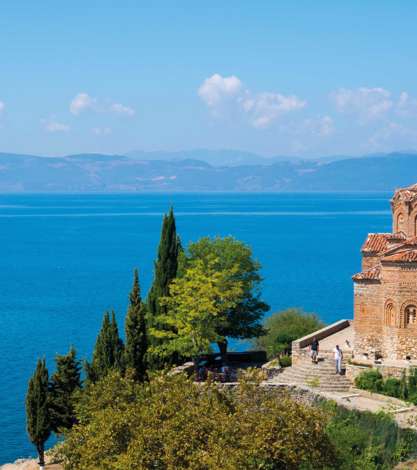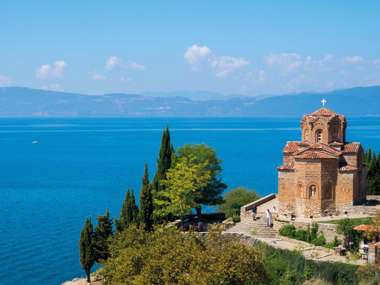Escorted Tours to North Macedonia
With mountains on every horizon and mile upon empty mile of rural tranquillity, much of North Macedonia is off the beaten track but its two main focal points are pure delight, the beauty and serenity of Lake Ohrid and Skopje’s clash of character and culture.
Why choose a tour in North Macedonia?
Little visited and largely unheralded, North Macedonia has been a well-kept secret for too long.
Its historic credentials include a lake 3,000 millennia old, the archaeological site of a 7th-century BC city, the remains of a 4th-century AD basilica, a medley of medieval churches, and a man-made lake in Matka Canyon, created in 1938 by the Treska River Dam.
Skopje is the country’s capital, largest city, and cultural hub. All but obliterated by the earthquake of 1963, it has been rebuilt in exuberant style, with dancing fountains, hundreds of statues in heroic proportions, and huge city squares, where modern monuments mimic neoclassical grandeur. These are counterbalanced by surviving historic landmarks, the colourful chaos of the Turkish Bazaar, the Stone Bridge crossing the river, and the ‘Kale’ fortress, overseeing all from its elevated Old Town.
Enchanting Ohrid has a rare UNESCO listing for both natural and cultural heritage. The natural part is its serene namesake lake, the oldest in Europe, its crystal-clear waters delving to depths of 288m, covering 138 square miles, and straddling the North Macedonia/Albania border. The cultural aspect is the shoreline town with its countless churches, simple or sublime. Many cling to the steep, cobbled streets, one crowns the Kaneo cliff, another is filled with fabulous frescoes, and the archaeological find of a five-aisled basilica reveals an ancient mosaic floor.
Stobi is the site of a 7th-century BC, Roman city. Invasions and an earthquake led to its demise about a thousand years later, and the city stayed lost and forgotten until 1920, when archaeologists uncovered a palace, a Christian baptistry with brilliant Byzantine mosaics, and a 7,600-seat theatre.
Jules Verne’s journey in North Macedonia is teamed with the highlights of neighbouring Albania and Kosovo.
When to go on North Macedonia holidays
The country’s continental climate can be summed up as cold and dry in winter, hot and dry in summer, and warm with some rain in spring and late autumn; with some variation between the valleys and mountains. In Skopje’s valley setting, average daytime temperatures in July and August are 32°, with the shoulder months around 24°; while the higher altitude of Ohrid is generally three or four degrees lower.
The most temperate months for touring are May and June, September and October.
Who are North Macedonia tours suited to?
With its canyons, mountains and waterways, North Macedonia’s landscape is a splendid backdrop for touring, and, within the country’s compact boundaries, the scenic route is never a long haul. Culture and nature, past and present are seamlessly interwoven, so photographers, historians and the simply curious will all find something to pique their interest.
On a Jules Verne tour, you will be travelling in a sociably small group of likeminded people.
Why book North Macedonia tours with Jules Verne?
With 45 years’ experience and a passion for creating extraordinary adventures, Jules Verne takes you to iconic landmarks and lesser-known sites, with expert tour guides who share their local knowledge, and show you hidden gems. Our journeys in North Macedonia include a wine tasting visit to the Popova Kula Winery, and a boat trip on Lake Ohrid.
Our guided tours to North Macedonia are ABTA and ATOL protected, so you can book with complete confidence.
Balkan Explorer
Touring a trio of intriguing countries, Kosovo, Albania, and North Macedonia, this journey highlights historic sites, spectacular scenery, and the cities whose heritage monuments and museums tell the tales of their ancient, Ottoman, medieval, and modern eras


